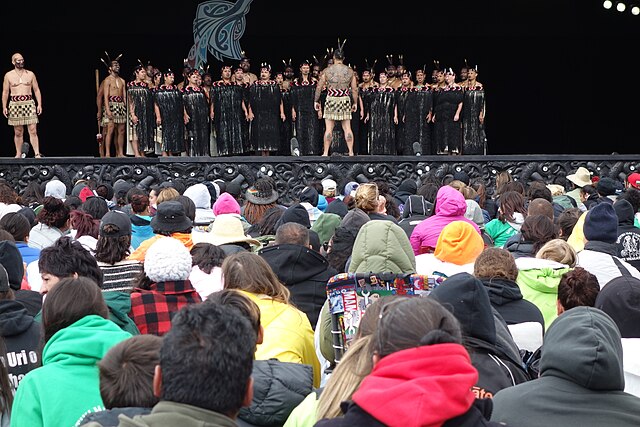Top Qs
Timeline
Chat
Perspective
Te Matatini
Biennial performing arts festival in New Zealand From Wikipedia, the free encyclopedia
Remove ads
Te Matatini is a nationwide Māori performing arts festival and competition for kapa haka performers from all of New Zealand and Australia. The name was given by Professor Wharehuia Milroy, a composite of mata meaning "face" and tini denoting "many" — hence the meaning of Te Matatini is "the many faces".[1]

This article has multiple issues. Please help improve it or discuss these issues on the talk page. (Learn how and when to remove these messages)
|
The Te Matatini festival is held every two years in different regions of New Zealand. Authority (mana) is given to different tribes (iwi) to host the festival. For example, in 2017 the mana was given to Te Whanganui-a-Tara on behalf of the Ngāti Kahungunu (Heretaunga) region.
Mead (2003) explains: Mana is undergone by a set of rules before it is given, the people or person in charge has to accept these constraints and strive to rise above them in order to do the job that is set before them.
Te Matatini is seen as playing a major role within Māoridom in promoting the tikanga of the Māori culture and kapa haka. The festival provides a valuable experience for the people of New Zealand and the world, with the festival attracting up to 30,000 participants and spectators.[2] Te Matatini celebrates the Māori culture, its beauty, and its core values. Kapa haka is a form of Māori identity and contributes to New Zealand being unique.
The Te Matatini Society is the driving force behind Te Matatini National Kapa Haka Festival. Initially emerging in the late 1960s, it has evolved into the sponsor of a variety of Māori festivals and Polynesian events. The society in its current form was established in 1972 and has focused on the long term nurturing of Māori performing arts.[3]
The most recent kapa haka competition, Te Matatini 2025, was held in New Plymouth at the Bowl of Brooklands from 25 February to 1 March 2025, hosted by Te Kāhui Maunga, the Taranaki/Whanganui regional authority.[4]
Remove ads
Regions
Remove ads
Schedule of events
Prizes
Prizes are awarded on the final competition day. Across the five days, each team are judged against set criteria, by expert judges, appointed from around New Zealand.
- The taonga (trophies) are awarded to the teams with the highest score in the seven compulsory (aggregate) and non-compulsory (non-aggregate) disciplines from the pool rounds.
- The toa whakaihuwaka (overall winner) taonga is awarded to the team with the highest scores from the final day (Te Matangirua) and also determines first second and third place.[6]
Disciplines
Summarize
Perspective
The performances are made up of different disciplines and each haka group is required to perform six disciplines within their performance piece or bracket - whakaeke (a choreographed entry), mōteatea (traditional chant), poi (light ball swung on the end of a rope), waiata-ā-ringa (action song), haka and whakawātea (exit). They must perfect every discipline in a polished 25-minute performance.[7]
Remove ads
Past winners
Remove ads
References
Further reading
External links
Wikiwand - on
Seamless Wikipedia browsing. On steroids.
Remove ads
